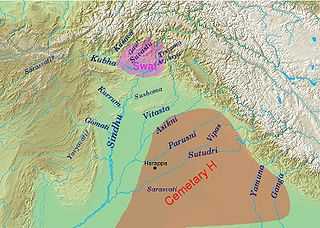Cemetery H culture

| Outline of South Asian history History of Indian subcontinent |
|---|
|
7000–3000 BC: Stone Age
|
|
3000–1300 BC: Bronze Age
|
|
1700–26 BC: Iron Age
|
|
21–1279 AD: Middle Kingdoms
|
|
1206–1596: Late medieval age
|
|
1526–1858: Early modern period
|
|
1505–1961: Colonial period
|
|
Other states (1102–1947)
|
|
Kingdoms of Sri Lanka
|
|
Regional histories |
The Cemetery H culture developed out of the northern part of the Indus Valley Civilization around 1700 BCE, in and around western Punjab region located in present-day India and Pakistan. It was named after a cemetery found in "area H" at Harappa.
The Cemetery H culture is part of the Punjab Phase, one of three cultural phases that developed in the Localization Era of the Indus Valley Tradition.[1] It is considered to be part of the Late Harappan phase.
Remains of the culture have been dated from about 1900 BCE until about 1300 BCE. Together with the Gandhara grave culture and the Ochre Coloured Pottery culture, it is considered by some scholars a nucleus of Vedic civilization.
Cremation in India is first attested in the Cemetery H culture, considered the formative stage of Vedic civilization. The Rigveda contains a reference to the emerging practice, in RV 10.15.14, where the forefathers "both cremated (agnidagdhá-) and uncremated (ánagnidagdha-)" are invoked.[2][3]
The distinguishing features of this culture include:[4]
- The use of cremation of human remains. The bones were stored in painted pottery burial urns. This is completely different from the Indus civilization where bodies were buried in wooden coffins. The urn burials and the "grave skeletons" were nearly contemporaneous.[5]
- Reddish pottery, painted in black with antelopes, peacocks etc., sun or star motifs, with different surface treatments to the earlier period.
- Expansion of settlements into the east.
- Rice became a main crop.
- Apparent breakdown of the widespread trade of the Indus civilization, with materials such as marine shells no longer used.
- Continued use of mud brick for building.
The Cemetery H culture also "shows clear biological affinities" with the earlier population of Harappa.[6]
The archaeologist Kenoyer noted that this culture "may only reflect a change in the focus of settlement organization from that which was the pattern of the earlier Harappan phase and not cultural discontinuity, urban decay, invading aliens, or site abandonment, all of which have been suggested in the past."[7]
See also
- Indus Valley Tradition
- Painted Grey Ware
- Copper Hoard Culture
Notes
- ↑ Kenoyer 1991a; Shaffer 1992
- ↑ Dudi, Amar Singh. Ancient India History. Neha Publishers and Distributors (January 10, 2012). Ch. 9. Vedic Religion, Rituals. ISBN 978-93-80318-16-5.
- ↑ Sabir, N. Heaven Hell OR??. Publisher: Xlibris (October 7, 2010). P. 155. ISBN 1453550119.
- ↑ http://pubweb.cc.u-tokai.ac.jp/indus/english/3_1_02.html
- ↑ Sarkar 1964
- ↑ Kennedy 2000, p. 312; Mallory & Adams 1997, pp. 103, 310
- ↑ Kenoyer 1991b, p. 56
References
- Kennedy, Kenneth A. R. (2000). God-Apes and Fossil Men: Palaeoanthropology of South Asia. Ann Arbor: University of Michigan Press.
- Kenoyer, Jonathan Mark (1991a). "The Indus Valley tradition of Pakistan and Western India". Journal of World Prehistory 5 (4): 1–64. doi:10.1007/BF00978474.
- Kenoyer, Jonathan Mark (1991b). "Urban Process in the Indus Tradition: A preliminary model from Harappa". In Meadow, R. H. (ed.). Harappa Excavations 1986-1990: A multidiscipinary approach to Third Millennium urbanism. Madison, WI: Prehistory Press. pp. 29–60.
- Mallory, J. P.; Adams, D. Q. (1997). Encyclopedia of Indo-European Culture. London and Chicago: Fitzroy-Dearborn. ISBN 1-884964-98-2.
- Sarkar, Sasanka Sekhar (1964). Ancient Races of Baluchistan, Panjab, and Sind.
- Shaffer, Jim G. (1992). "The Indus Valley, Baluchistan and Helmand Traditions: Neolithic Through Bronze Age". In Ehrich, R. W. Chronologies in Old World Archaeology (Second ed.). Chicago: University of Chicago Press. pp. I:441–464, II:425–446.
- http://www.harappa.com
- http://pubweb.cc.u-tokai.ac.jp/indus/english/3_1_01.html
| ||||||||||||||||||||